When History Shifted In Newfoundland Waters: The Atlantic Charter, 1941
By Neil Earle
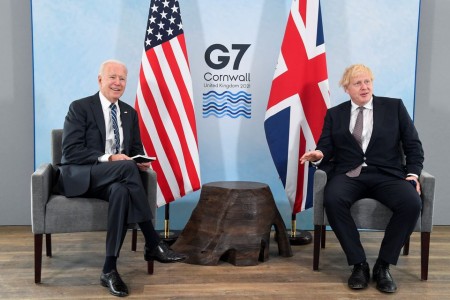 Britain's Prime Minister Boris Johnson meets with U.S. President Joe Biden, ahead of the G7 summit, at Carbis Bay, Cornwall, Britain June 10, 2021. REUTERS/Toby Melville/Pool
Britain's Prime Minister Boris Johnson meets with U.S. President Joe Biden, ahead of the G7 summit, at Carbis Bay, Cornwall, Britain June 10, 2021. REUTERS/Toby Melville/PoolThe June, 2021 summit between President Joe Biden of the United States and the Prime Minister of Great Britain had an added touch that stirred the memories of the historically-minded in the Tenth Province. At Cornwall, the two leaders added clauses to “revise” or update for the age of cyber-warfare one of the crucial documents from World War Two: the Atlantic Charter issued from Placentia Bay in August 1941. It was eighty years ago when the then-island nation of Newfoundland was the stage set for one of history’s decisive turns: a secret meeting between Prime Minister Winston Churchill of Great Britain and President Franklin D. Roosevelt (FDR) of the United States.
For more than two days, amid what had to be one of the darkest periods in Western civilization, Churchill, Roosevelt and their military advisors met to take each other’s measure as well as map out a plan of action in the face of darkening news from Soviet Russia. The Nazis were clobbering the Red Army left and right. “Moscow is gone” Churchill had said in private that summer. It was proving vital for the two North Atlantic powers to ascertain where and when the vast American productive capacity, freshly aroused, could best help their British customers. “Customers,” not Allies, because the United States was not then at war. The Japanese attack at Pearl Harbor was still four months away (December 7, 1941). The British were hanging on by their fingernails after being chased off the continent of Europe in 1940 and the lethal indiscriminate bombing of her major cities in the winter of 1940-1941.
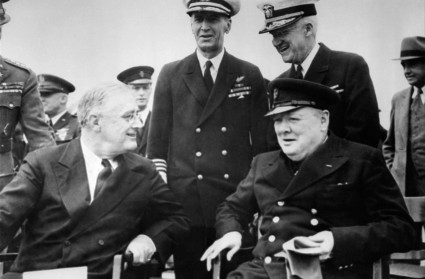 This rendezvous of two talented leaders on the stage of world history – Churchill and Roosevelt – offered a foreshadowing of the way the world was going to go for the next 60 years.
This rendezvous of two talented leaders on the stage of world history – Churchill and Roosevelt – offered a foreshadowing of the way the world was going to go for the next 60 years.The Vital Lifeline
Above all it was necessary to focus on what help the Americans could give in securing what Churchill considered the most important lifeline of the war: the vital convoy supplies to England, the “sea roads” that kept embattled Britain supplied. FDR wanted to help, indeed had done much already with the Lend Lease Act of March 1941 whereby seven billion dollars of aid was scheduled to flow across the Atlantic. But he was dealing with a jittery Congress and a still isolationist country, one that was more interested, in the words of one journalist, “in a dog fight behind Main Street than a world at war.” On his part the wily Churchill wanted an Atlantic meeting to try and bring the United States in as a belligerent. But FRD was proving wilier still and the meeting off Ship Harbor in Placentia Bay, crucial as it was for all that would follow, would focus at first in forestalling the possible designs of Imperial Japan.
Yet when an empire’s life is at stake a meeting of minds can be essential. This is what made the meeting in the wide waters of Placentia Bay that August of 1941 so important, then and now. Indeed, this rendezvous of two talented leaders on the stage of world history – Churchill and Roosevelt – offered a foreshadowing of the way the world was going to go for the next 60 years. The United States was beginning her ascent to world power, Britain was staggering under the weight of global responsibilities she could no longer fulfill, and for Newfoundland, the American warships in Placentia Bay served notice of how much things were going to change in the years ahead. “The Yanks were coming.” Some 977 of them had already moved into St. John’s that January, 1941. This was part of the “destroyers for bases” deal of September, 1940 whereby 50 older U.S. destroyers would be used by the Royal Navy to better hunt down the U-boats infesting the North Atlantic.
Thus the meeting at Placentia Bay was more than just symbolic for the people of Newfoundland and Labrador. Real results had gone beforehand. Under Lend-Lease the Americans were fast building naval and air bases at St. John’s, and near Ship Harbor at Argentia. The Argentia installation would prove a most decisive base for winning the Battle of the Atlantic. It would also pump $300,000,000 into the Newfoundland economy and prove an economic magnet which lasted until 1994. “At the height of the base-building boom,” according to Peter Neary in his Newfoundland in the North Atlantic World: 1929-1949, “about 20,000 Newfoundlanders were employed in military construction, which in effect, had suddenly, some would say providentially given the country a major new industry.” My own father remembers never having had so much money in his life and “the Yanks” made an overall good impression around the Avalon Peninsula. The more prophetic reality was that the appearance of the American president in home waters drove home that this former British possession was about to be drawn more into the American orbit and steadily away from connections to the British Empire. The American eagle was beginning to soar. Where the eagle flew the Canadian beaver would soon nervously follow. RCAF bases at Torbay and Gosse Bay took shape as Ottawa tried diplomatically to “shadow” what the American were doing. Canada did not want an “Eastern Alaska” on their Atlantic front.
All of this led to Neary’s “economic miracle” of 1941-1942 as the dominion began to pull out of the Great Depression at last and set waves rolling that would set up the Confederation battles of 1948-1949.
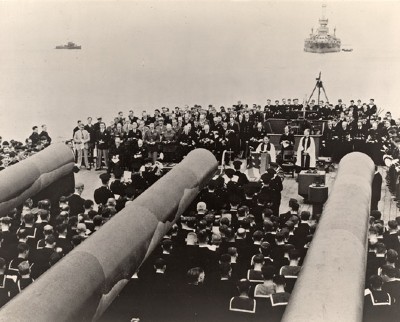 The British hosted the Americans aboard the brand new HMS Prince of Wales for a Sunday church service.
The British hosted the Americans aboard the brand new HMS Prince of Wales for a Sunday church service.The First Summit
What the public saw from the Argentia conclave – in essence the first real “summit meeting” – was what the British press dubbed “the Atlantic Charter.” It was essentially FDR’s idea but drafted by the British. There was an eight-fold declaration of joint principles of international law as understood by the English-speaking nations across the span of hundreds of years. It breathed the spirit of traditional liberal democracy without committing the United States to any overt action. It was far-reaching in what it presaged. The fifth article mentioned the phrase “effective international organization” after the coming about of “a peace which will…cast down forever the Nazi tyranny.” Article Eight called for all nations to seek “an abandonment of the use of force” in the future. This was a utopian-sounding proposal but it underscored the desperation of the times. If utopian it was an idealism born out of bitter realties and a large step on the way to what would become the United Nations. Historian Max Hastings has praised the “noble phrases in support of a common commitment to freedom,” enshrining traditional principles that gave hope to conquered peoples around the globe. It was also a step in the gesture towards upholding some key principles of international law which even brutal dictators sometimes violate at their peril.
Though some think otherwise, the Atlantic Charter was not just a recitation of wartime propaganda. People fighting for their lives – as we were back then – often need reminding more than instruction. The joint declaration of August, 1941 (though unsigned) helped raise the moral bar in international affairs. The hope that justice would eventually be served on aggressors was one important implication but it also reaffirmed in its third article the principle of self-governance so dear to the heart of Western nations. The Charter respected the right of all people to choose the form of government under which to live, tenets which are still being fought out from Myanmar to Managua and beyond: in a word, the rule of law, the rights of individual citizens to choose their own form of government.
Broad statements of idealistic principles might seem unrelated to the “real world realities” but international law is fragile enough to need restating. It was Napoleon Bonaparte who stated, somewhat astonishingly perhaps, that there are only two forces in the world of power, the sword and the Spirit. The Spirit, he said, was infinitely more powerful in the long run. According to the military historian Max Hastings, the Charter’s “noble phrases in support of a common commitment to freedom” enshrined principles that, argues Hastings, gave hope to struggling subject people around the world (Winston’s War, page 168). Gifted communicators such as Churchill and FDR understood instinctively that oppressed peoples need hope, something to fight for beyond the sometimes-enervating noise of the present, the heart-stopping ups and downs of history.
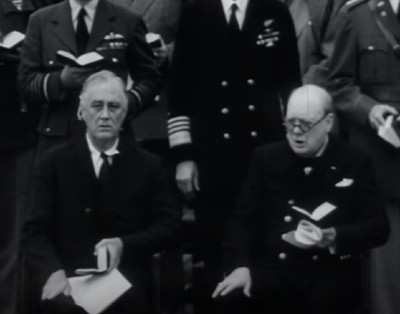 FDR and Churchill singing “Onward Christian Soldiers.”
FDR and Churchill singing “Onward Christian Soldiers.”The Spreading Effects
What immediately came out of it was FDR’s offer of 150,000 old rifles to the British and his determination the very next month that American naval vessels would “shoot on sight” any German U-Boats seen in the North Atlantic. This was pushing his presidential powers almost to the limit. Out of the new naval base at Argentia would sail the Reuben James in October that same year. Her sinking off Iceland with 100 Americans lost would do much to stiffen American attitudes for war with Hitler. Indeed, Hastings claims that FDR intended to “provoke war” not in the Pacific – as conspiracy theorists like to suppose – but in the North Atlantic where the U.S. Navy had already taken over escort duty for the convoys steaming from the east coast.
The Sunday of the summit offered a grand moment that hearkened back to the very roots of Western culture. The British hosted the Americans aboard the brand new HMS Prince of Wales for a Sunday church service. The pulpit was draped with flags of two nations. As if to summon up the latent spiritual forces so vital in times of peril, Churchill himself picked the hymns: “Onward Christian Soldiers,” “O God Our Help in Ages past,” and – for the Americans – “Eternal Father Strong to Save.” An unknown clerk on the quarter deck emoted “My God, this is history.” It was indeed. As Churchill later wrote: “It was a great hour to live. Nearly half those who sang were soon to die.” This was an allusion to the sinking of Prince of Wales by Japanese planes that December.
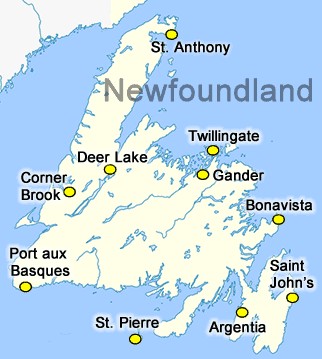
“Gibraltar of the West”
In World War Two Newfoundland and Labrador’s strategic position came into full view. So many convoys snaked through the narrow neck of the Straits of Belle Isle that both Germans and Americans established small weather bases on the Labrador coast. “Gibraltar of the West,” we were called, as Neary documents. In his war memoirs Winston Churchill himself noted that “the most important [base] for the North Atlantic convoys was Argentia, in Newfoundland” (The Grand Alliance, page 138).
Neary’s account also reminds us that progress has its cost. To make way for the U.S. military the remains of 625 individuals were exhumed from the old graveyard at Argentia and reinterred in the new cemetery at Freshwater. This indignity has not been forgotten. Newfoundland drivers had to switch to the right side of the road when entering American territory and work alongside Americans who could buy duty free cigarettes at seven cents a pack. Labor troubles soon emerged and an Argentia Labor Union took shape soon after the first soldiers arrived.
Here might be another lesson for today, we the heirs of that freedom-loving generation. Even with survival at risk, as in 1941, the tensions in a democracy, between labor and management, between insiders and outsiders, between those with aspiration and those on the plateau, these are eternal struggles. Yet in spite of it all, the faint echoes of 1941 emanating from Cornwall this summer reminds us of how nothing great is achieved without sacrifice and that worthy values matter greatly when the chips are down. Looking back at the war overall, Hastings summarized, “here was something which our parents and grandparents did well in a noble cause.” Democracy on the march and ultimately ascendant with Newfoundland and Labrador in the middle of it all.